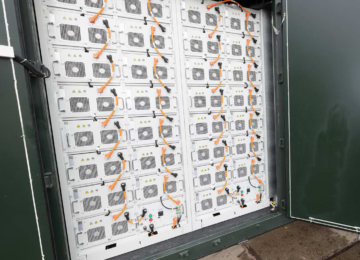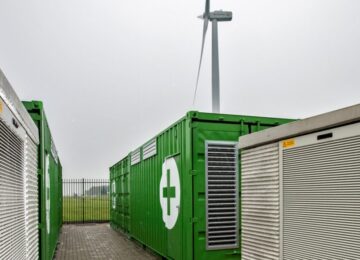RIVM maps safety risks of battery storage, ESNL warns of unnecessary concerns
RIVM today published a new calculation method for mapping the environmental safety risks of energy storage systems (EOS) and lithium-ion battery storage. The method was developed on behalf of the Ministry of Infrastructure and Water Management (IenW) and will be included in future laws and regulations in this area. Energy Storage NL is concerned about practicality and that unnecessarily distant safety distances will apply to battery systems.
Reason for the study
The emergence of large-scale energy storage systems in the Netherlands, such as batteries based on lithium-ion technology, has drawn attention to their potential risks to the external environment. RIVM was commissioned by the Ministry of IenW in 2023 to investigate whether these systems pose relevant safety risks to the external environment, particularly in the event of incidents such as explosions or the release of toxic substances.
The study complements the so-called Hazardous Substances Publication Series (PGS37-1), which lays down guidelines for the safe handling of hazardous substances including lithium-based energy carriers (batteries) above 20kWh. The insights from the RIVM study are intended as scientifically based advice to the Ministry of IenW, which uses them as a basis to make policy choices and ultimately draft new regulations.
The calculation method developed by RIVM can be used to calculate the safe distances to be maintained between these storage systems and vulnerable objects, such as homes, schools and hospitals.
RIVM conclusions and proposals.
The RIVM concludes that energy storage systems can indeed pose risks to the immediate environment in certain scenarios, particularly if there is an explosion or the creation of a toxic cloud. The full study is here summarized and downloadable.
The RIVM therefore suggests explicit consideration of environmental safety when placing energy storage systems. The published calculation method allows policy makers and planners to determine, on a situation-by-situation basis, at what distance from buildings a system can be safely placed.
In addition to this customizable method, the report also includes a table of fixed distances. These distances are based on conservative calculations that summarize different scenarios. Although this table provides clarity, in some cases it may lead to larger - perhaps unnecessarily wide - distance requirements. Therefore, RIVM recommends that the possibility of calculating with the method be kept open so that smaller, but still safe, distances can be established in specific cases.
Response Energy Storage NL (ESNL).
Energy Storage NL (ESNL) actively contacted RIVM about this research in May 2024. ESNL and members from the Safety Working Group have shared data sheets of battery storage systems and information about incidents, among other things. Since October, ESNL has also been part of the guidance committee around the calculation methodology. This involvement reflects the industry's desire for constructive input on safe and workable regulations.
While ESNL recognizes the importance of the method, there is also criticism from the industry. Many companies have difficulty in properly understanding the content of the method. The concepts used, the assumptions made and the implications of choices are not always clearly explained. This has led to unease, particularly around the published fixed distance table, which in some cases seems to suggest substantial restrictions on market developments.
ESNL is therefore calling on the Ministry of IenW to work with the industry to look at the practicality of the recommendations. The organization strives for a balance between safety and innovation and is happy to discuss this with the ministry. ESNL also calls for clear communication towards market parties and municipalities and will make every effort to continue to provide input during consultations and in-depth sessions.
Coherence with EU legislation: battery regulation
In addition, ESNL notes the importance of alignment with existing European regulations. Since Aug. 18, 2024, the EU Battery Regulation (EU 2023/1542) has been in force. This regulation sets sustainability rules for batteries throughout their life cycle and applies to all batteries that store and supply electricity, including Battery Energy Storage Systems (BESS).
Article 12 of the regulation specifically states that stationary battery systems (as defined in Article 3.15) must be safe under normal use. This must be demonstrated through technical documentation, including testing according to the safety parameters from annex V of the regulation. The European Commission can adjust these parameters through a delegated act. To date, there are no signs that the Commission will do so in the near future. Recent discussions with the ministry indicate that the exact technical requirements are currently still under development; delivery is expected in the course of this year.
ESNL emphasizes that national safety frameworks such as the new RIVM calculation method should be in line with these European obligations to avoid duplication of regulations, ambiguity and unnecessary burdens for companies.
Follow-up steps by the Ministry of IenW
The Ministry of Infrastructure and Water Management states that when making policy it wants to minimize risks to the environment, while leaving room for the development of battery systems. Therefore, the following actions have been announced:
- In-depth sessions with RIVM., in which there will be room for technical questions and practical examples.
- A consequence study after the summer, to get a realistic picture of how the method will be applied in practice.
- Research on regulatory burden and business burden, to test workability for businesses and municipalities.
- An Internet consultation in the fall, in which stakeholders can express their views on proposed laws and regulations.
The Ministry emphasizes that it will keep the sector closely informed of all developments and allow for input from all parties involved. ESNL remains committed to a common course in which battery storage is given a responsible place within the energy system of the future, although it is important to ESNL that projects are not hindered by unnecessary objections.





